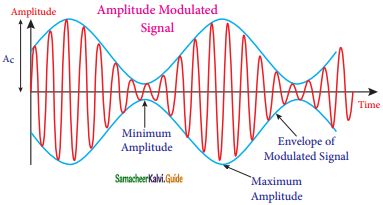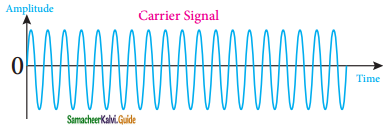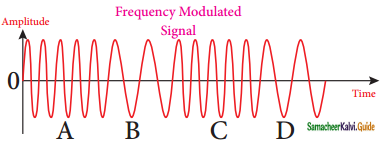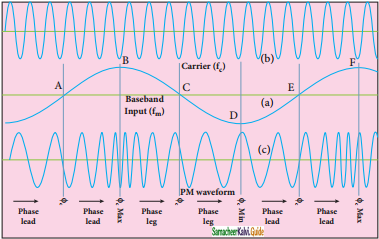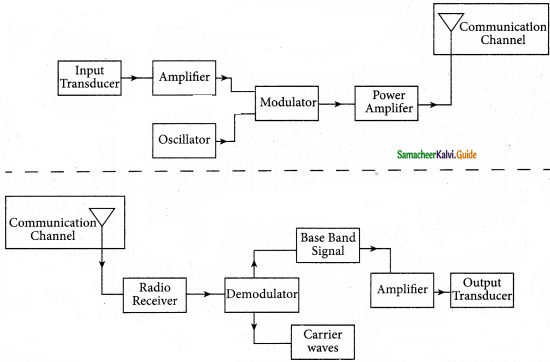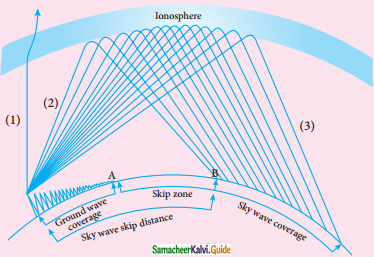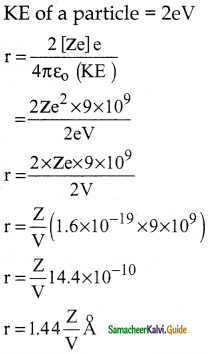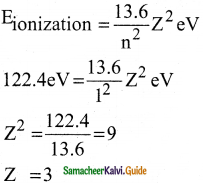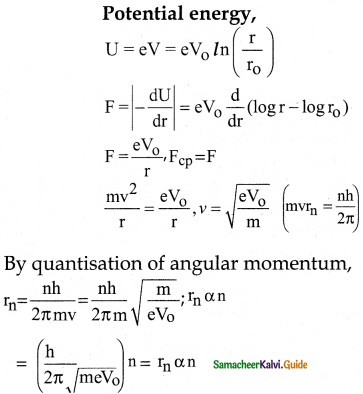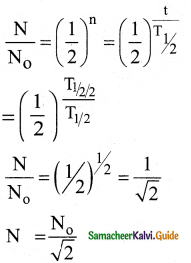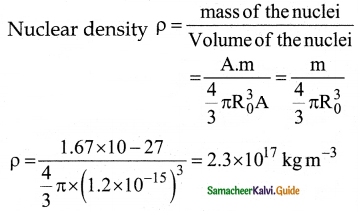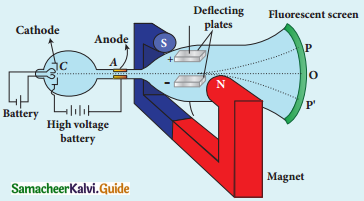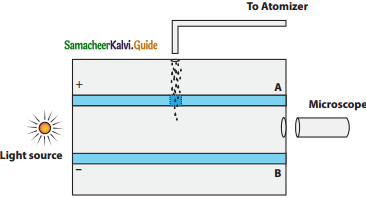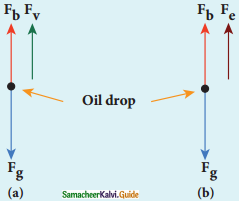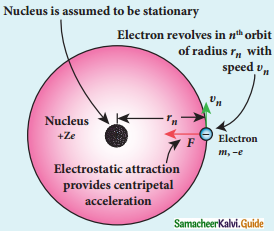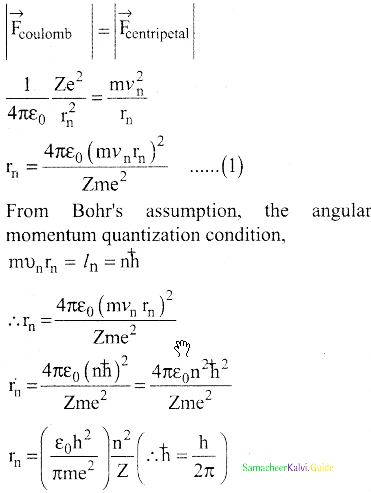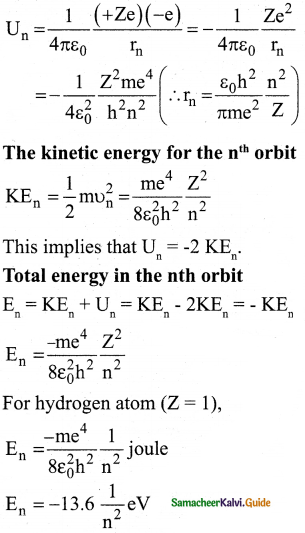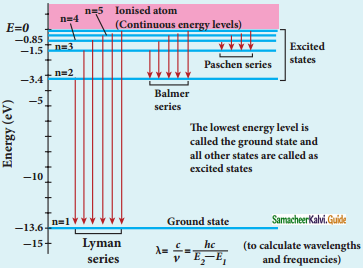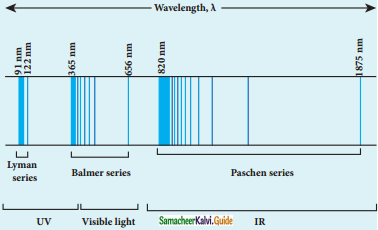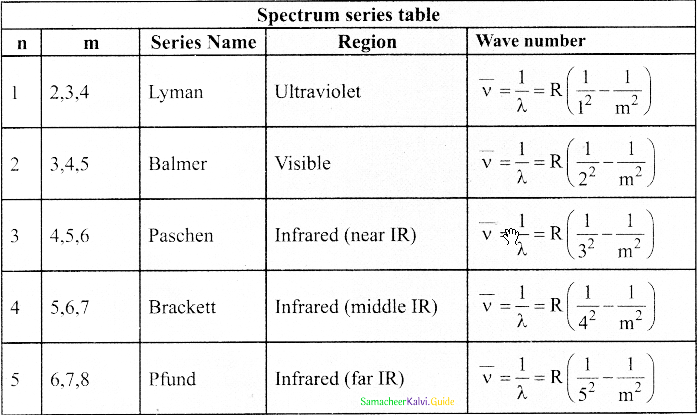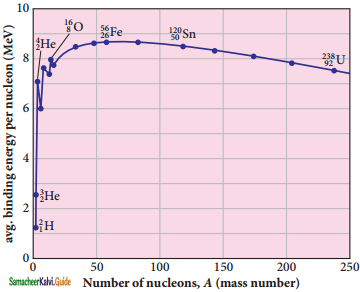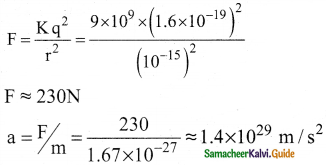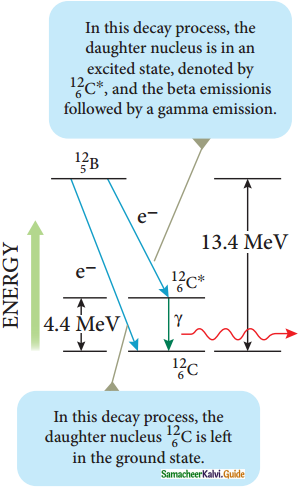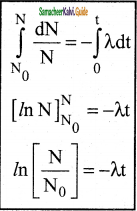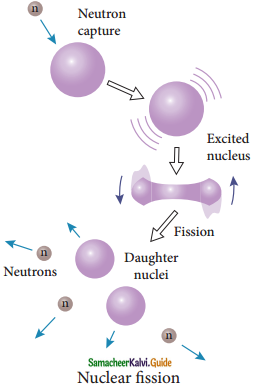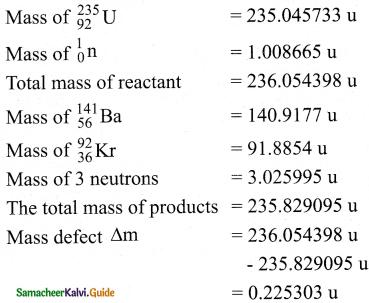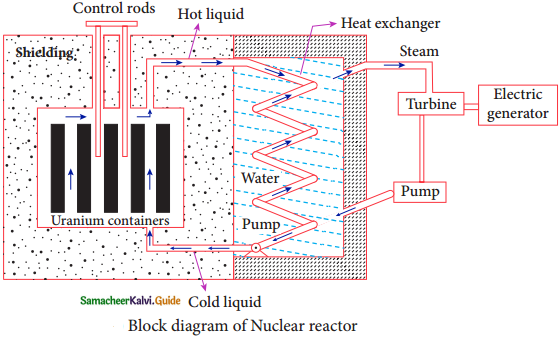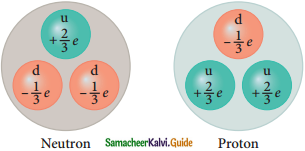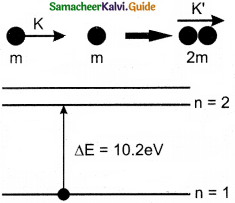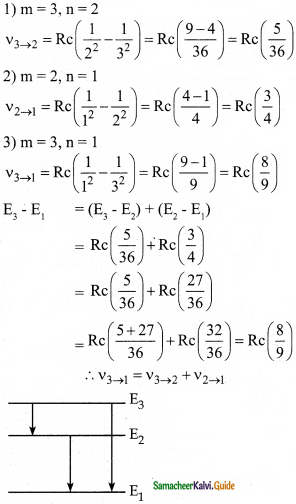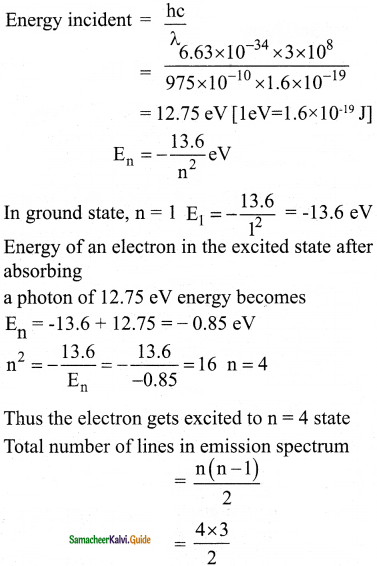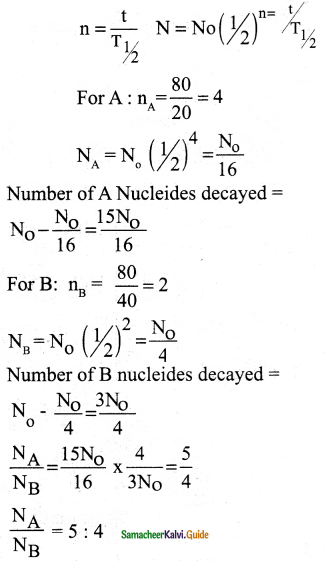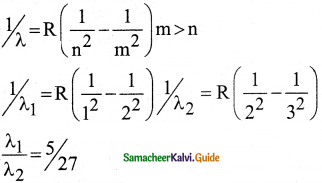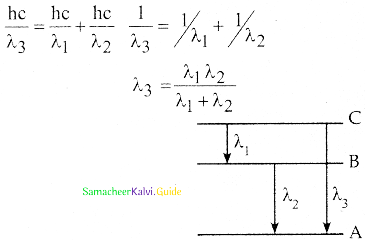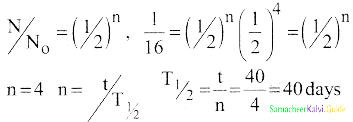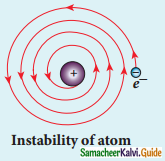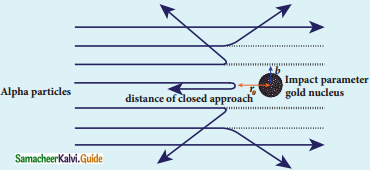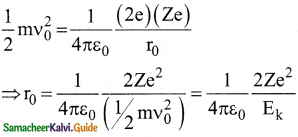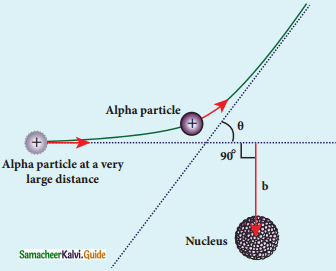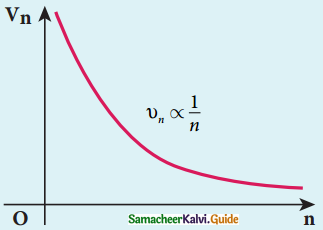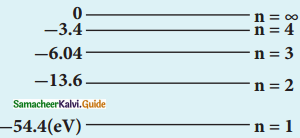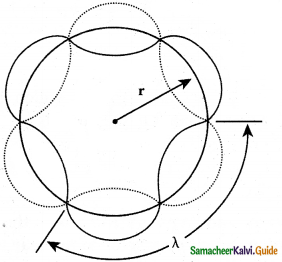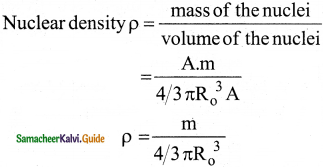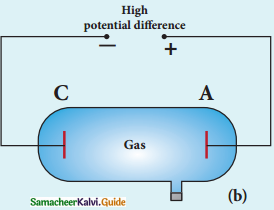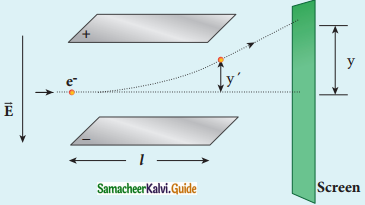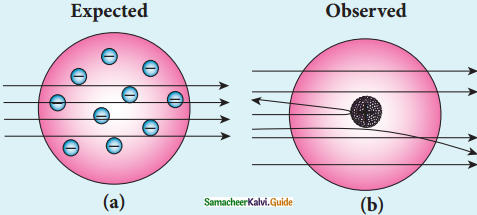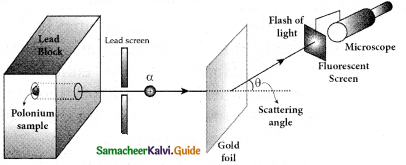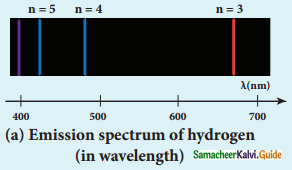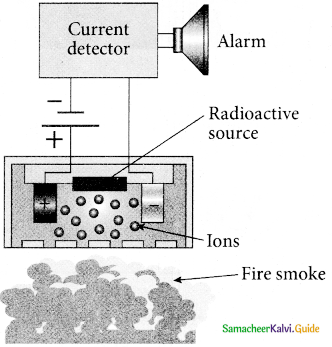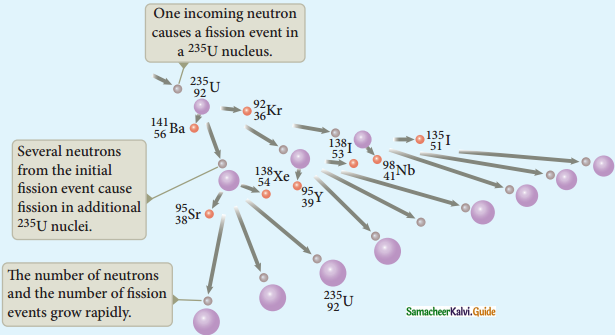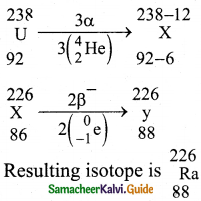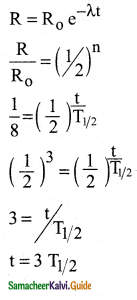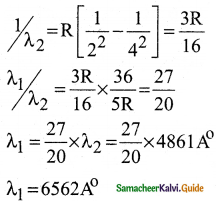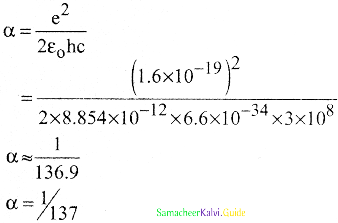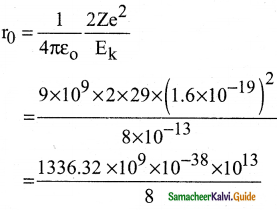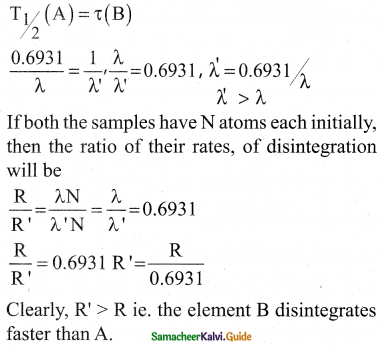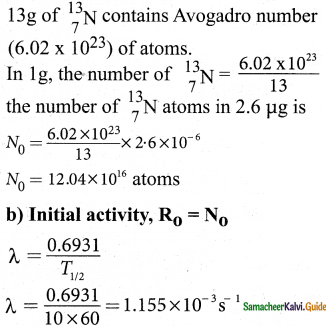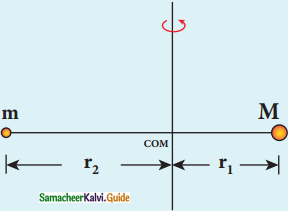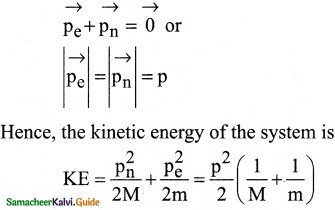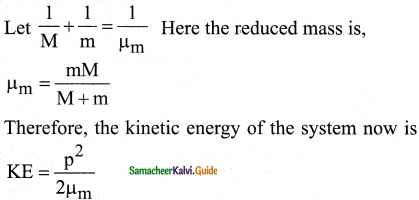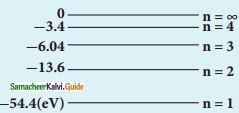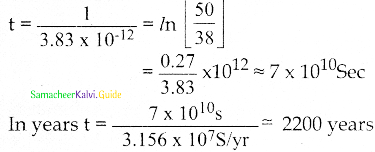Tamilnadu State Board New Syllabus Samacheer Kalvi 12th Physics Guide Pdf Chapter 11 Recent Developments in Physics Text Book Back Questions and Answers, Notes.
Tamilnadu Samacheer Kalvi 12th Physics Solutions Chapter 11 Recent Developments in Physics
12th Physics Guide Recent Developments in Physics Text Book Back Questions and Answers
Part – I
TextBook Evaluation:
I. Multiple Choice Questions:
Question 1.
The particle size of ZnO material is 30 nm. Based on the dimension it is classified as
a) Bulk material
b) Nanomaterial
c) Soft material
d) Magnetic material
Answer:
b) Nanomaterial
Question 2.
Which one of the following is the natural nanomaterial.
a) Peacock feather
b) Peacock beak
c) Grain of sand
d) Skin of the Whale
Answer:
a) Peacock feather
Question 3.
The blue print for making ultra-durable synthetic material is mimicked from ________.
a) Lotus leaf
b) Morpho butterfly
c) Parrot fish
d) Peacock feather
Answer:
c) Parrot fish
Question 4.
The method of making nanomaterial by assembling the atoms is called ______.
a) Top down approach
b) Bottom up approach
c) Cross down approach
d) Diagonal approach
Answer:
b) Bottom up approach
Question 5.
“Sky wax” is an application of nano product in the field of ________.
a) Medicine
b) Textile
c) Sports
d) Automotive industry
Answer:
c) Sports
![]()
Question 6.
The materials used in Robotics are ________.
a) Aluminium and silver
b) Silver and gold
c) Copper and gold
d) Steel and aluminium
Answer:
d) Steel and aluminium
Question 7.
The alloys used for muscle wires in Robots are _______.
a) Shape memory alloys
b) Gold copper alloys
c) Gold silver alloys
d) Two-dimensional alloys
Answer:
a) Shape memory alloys
Question 8.
The technology used for stopping the brain from processing pain is ______.
a) Precision medicine
b) Wireless brain sensor
c) Virtual reality
d) Radiology
Answer:
c) Virtual reality
Question 9.
The particle which gives mass to protons and neutrons are _______.
a) Higgs particle
b) Einstein particle
c) Nanoparticle
d) Bulk particle
Answer:
a) Higgs particle
Question 10.
The gravitational waves were theoretically proposed by _______.
a) Conrad Rontgen
b) Marie Curie
c) Albert Einstein
d) Edward Purcell
Answer:
c) Albert Einstein
![]()
II. Short Answers Questions:
Question 1.
Distinguish between Nanoscience and Nanotechnology.
Answer:
| Nanoscience | Nanotechnology |
| 1. Nanoscience is the science of objects with a typical size of 1-100 nm. Nano means one-billionth of a metre that is 10-9m. | Nanotechnology is a technology involving design, production. |
| 2. If matter is divided into such small objects the mechanical, electrical, optical magnetic and other properties change. | Characterization and application of nano structured materials. |
Question 2.
What is the difference between Nano materials and Bulk materials?
Answer:
| Nano Materials | Bulk Mateerials |
| 1. Nano materials are particle that have their size in 1-100 nm range atleast in one dimension. | Bulk materials are particle that have their size above lOOnm in all dimensions. |
| 2. We cannot see particles of nanomaterials from the naked eye. | We can see particle of most of the bulk materials from the naked eye. |
| 3. The example of nanomaterials include nano zymes, titanium dioxide, nano particles, graphene, etc. | The example of bulk materials include plaster sand, gravel, cement, ore, slag, salts, etc. |
Question 3.
Give any two examples for “Nano” in nature.
Answer:
1. Single-strand DNA:
A single strand of DNA, the building block of all living things, is about three nanometers wide.
2. Morpho Butterfly:
The scales on the wings of a morpho butterfly contain nanostructures that change the way light waves interact with each other, giving the wings brilliant metallic blue and green hues. Mimic in laboratories – Manipulation of colours by adjusting the size of nanoparticles with which the materials are made.
Question 4.
Mention any two advantages and disadvantages of Robotics.
Answer:
Advantage:
- The robots are much cheaper than humans.
- Robots never get tired like humans.
- Stronger and faster than humans.
Disadvantage:
- Robots have no sense of emotions or conscience.
- They lack empathy and hence create an emotionless workplace.
- Unemployment problem will increase.
Question 5.
Why steel is preferred in making Robots?
Answer:
Steel is several times stronger. In any case, because of the inherent strength of metal, robot bodies are made using a sheet, bar, rod, channel, and other shapes.
![]()
Question 6.
What are black holes?
Answer:
- Black holes are the end-stage of stars which are the highly dense massive objects. Its mass ranges from 20 times mass of the sun to 1 million times mass of the sun.
- It has very strong gravitational force such that no particle or even light can escape from it.
- The existence of black holes is studied when the stars orbiting the black hole behave differently from the other stars. Every galaxy has a black hole at its center.
Question 7.
What are sub atomic particles?
Answer:
- The three main subatomic particles that form an atom are protons, neutrons, and electrons.
- Subatomic particles are particles that are smaller than the atom, proton and neutron are made up of quarks which is interact through gluons.
- A subatomic particle having two types of particles, they are elementary particles and composite particles.
III. Long Answer Questions:
Question 1.
Discuss the applications of Nanomaterials in various fields.
Answer:
(i) Automotive industry:
- Lightweight construction
- Painting (fillers, base coat, clear coat)
- Catalysts
- Tires (fillers)
- Sensors
- Coatings for window screen and car bodies
(ii) Chemical industry:
- Fillers for paint systems
- Coating systems based on nanocomposites
- Impregnation of papers
- Switchable adhesives
- Magnetic fluids
(iii) Engineering
- Wear protection for tools and machines (anti blocking coatings, scratch resistant coatings on plastic parts, etc.)
- Lubricant – free bearings
(iv) Electronic industry
- Data memory
- Displays
- Laser diodes
- Glass fibres
- Optical switches
- Filters (IR-blocking)
- Conductive, antistatic coatings
(v) Construction:
- Construction materials
- Thermal insulation
- Flame retardants
- Surface – functionalised building materials for wood, floors, stone, facades, tiles, roof tiles, etc.
- Facade coatings
- Groove mortar
(vi) Medicine:
- Drug delivery systems
- Contrast medium
- Prostheses and implants
- Agents in cancer therapy
- Active agents
- Medical rapid tests
- Antimicrobial agents and coatings
(vii) Textile / fabrics / non – wovens:
- Surface – processed textiles
- Smart clothes
(viii) Energy:
- Fuel cells
- Solar cells
- Batteries
- Capacitors
(ix) Cosmetics:
- Sun protection
- Lipsticks
- Skin creams
- Tooth paste
(x) Food and drinks:
- Package materials
- Additives
- Storage life sensors
- Clarification of fruit juices
(xi) Household:
- Ceramic coatings for irons
- Odors catalyst
- Cleaner for glass, ceramic, floor, windows
(xii) Sports / outdoor:
- Ski wax
- Antifogging of glasses/goggles
- Antifouling coatings for ships/boats
- Reinforced tennis rackets and balls.
![]()
Question 2.
What are the possible harmful effects of the usage of Nanoparticles? Why?
Answer:
- The research on the harmful impact of the application of nanotechnology is also equally important and fast developing.
- The major concern here is that the nanoparticles have the dimensions same as biological molecules such as protein.
- They may easily get absorbed onto the surface of living organisms and they might enter the tissues and fluids of the body.
- The interaction with living systems is also affected by the dimensions of the nanoparticles.
- For instance, nanoparticles of a few nanometers size may reach well inside biomolecules.
- It is also possible for the inhaled nanoparticles to reach the blood to reach other sites such as the liver, heart, or blood cells.
- Researchers are trying to understand the response of living organisms to the presence of nanoparticles of varying size, shape, chemical composition, and surface characteristics.
Question 3.
Discuss the functions of key components in Robots?
Answer:
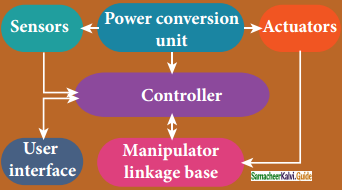
Power conversion unit:
Robots are powered by batteries, solar power, and hydraulics.
Actuators:
- Converts energy into movement.
- The majority of the actuators produce rotational (or) linear motion.
Most robots are composed of 3 main parts.
The Controller:
- This is also known as the “brain” which is run by a computer program.
- It gives commands for the moving parts to perform the job.
Most robots are composed of 3 main parts.
Mechanical parts:
- Motors
- Pistons
- Grippers
- Wheels and gears that make the robot move, grab, turn and lift.
Sensors:
- To tell the robot about its surroundings.
- It helps to determine the sizes and shapes of the objects around, the distance between the objects, and the directions as well.
![]()
Question 4.
Elaborate any two types of Robots with relevant examples.
Answer:
(i) Human-Robot: Certain robots are made to resemble humans in appearance and replicate human activities like walking, lifting, and sensing, etc.
- Power conversion unit: Robots are powered by batteries, solar power, and hydraulics.
- Actuators: Converts energy into movement. The majority of the actuators produce rotational or linear motion.
- Electric motors: They are used to actuate the parts of the robots like wheels, arms, fingers,
legs, sensors, camera, weapon systems etc. Different types of electric motors are used. The most often used ones are AC motor, Brushed DC motor, Brushless DC motor, Geared DC motor, etc. - Pneumatic Air Muscles: They are devices that can contract and expand when air is pumped inside. It can replicate the function of a human muscle. The contract almost 40% when the air is sucked inside them.
- Muscle wires: They are thin strands of wire made of shape memory alloys. They can contract by 5% when an electric current is passed through them.
- Piezo Motors and Ultrasonic Motors: Basically, we use it for industrial robots.
- Sensors: Generally used in task environments as it provides information of real-time knowledge.
- Robot locomotion: Provides the types of movements to a robot.
The different types are:- Legged
- Wheeled
- Combination of Legged and Wheeled Locomotion
- Tracked slip/skid.
(ii) Industrial Robots:
Six main types of industrial robots:
- Cartesian
- SCARA (Selective Compliance Assembly Robot Arm)
- Cylindrical
- Delta
- Polar
- Vertically articulated
Six-axis robots are ideal for:
- Arc Welding
- Spot Welding
- Material Handling
- Machine Tending
- Other Applications
Question 5.
Comment on the recent advancement in medical diagnosis and therapy.
Answer:
The recent advancement in medical diagnosis and therapy:
- Virtual reality
- Precision medicine
- Health wearables
- Artificial organs
- 3 – D printing
- Wireless brain sensors
- Robotic surgery
- Smart inhalers
1. Virtual reality:
Medical virtual reality is effectively used to stop the brain from processing pain and cure soreness in the hospitalized patients. Virtual reality has enhanced surgeries by the use of 3D models by surgeons to plan operations. It helps in the treatment of Autism, Memory loss, and Mental illness.
2. Precision medicine:
Precision medicine is an emerging approach for disease treatment and prevention that takes into account individual variability in genes, environment, and lifestyle for each person. In this medical model, it is possible to customise healthcare, with medical decisions, treatments, practices, or products which are tailored to the individual patient.
3. Health wearables:
A health wearable is a device used for tracking a wearer’s vital signs or health and fitness-related data, location, etc. Medical wearables with artificial intelligence and big data provide an added value to healthcare with a focus on diagnosis, treatment, patient monitoring, and prevention.
Note Big Data: Extremely large data sets that may be analysed computationally to reveal patterns, trends, and associations, especially relating to human behavior and interactions.
4. Artificial organs:
An artificial organ is an engineered device or tissue that is implanted or integrated into a human. It is possible to interface it with living tissue or to replace a natural organ. It duplicates or augments a specific function or functions of human organs so that the patient may return to normal life as soon as possible.
5. 3D printing:
Advanced 3D printer systems and materials assist physicians in a range of operations in the medical field from audiology, dentistry, orthopedics, and other applications.
6. Wireless brain sensors:
Wireless brain sensors monitor intracranial pressure and temperature and then are
absorbed by the body. Hence there is no need for surgery to remove these devices.
7. Robotic surgery:
Robotic surgery is a type of surgical procedure that is done using robotic systems. Robotically-assisted surgery helps to overcome the limitations of pre – existing minimally invasive surgical procedures and to enhance the capabilities of surgeons performing open
surgery.
8. Smart inhalers:
Inhalers are the main treatment option for asthma. Smart inhalers are designed with health systems and patients in mind so that they can offer maximum benefit. Smart inhalers use Bluetooth technology to detect inhaler use, remind patients when to take their medication, and gather data to help guide care.
![]()
Part – II:
12th Physics Guide Recent Developments in Physics Additional Questions and Answers
I. Match the following:
Question 1.
| I | II |
| 1. Molecule | a. Located in the center of an atom |
| 2. Nucleon | b. Electrons revolving around the atomic nucleus |
| 3. Atom | c. Protons & Neutrons comprising the nucleus of an atom |
| 4. Nucleus | d. Composed of two (or) more |
Answer:
- d
- c
- b
- a
Question 2.
| I | II |
| 1. Geroge Devol | a. Audiology |
| 2. Nano | b. No need surgery |
| 3. Wireless brain sensors | c. One billionth of a meter (109 m) |
| 4. 3D Printing | d. Unimate |
Answer:
- d
- c
- b
- a
Question 3.
| I | II |
| 1. Higgs Particle | a. Slavic word |
| 2. Albert Einstein | b. Mass of particle |
| 3. Black Holes | c.Gravitational waves |
| 4. Robot | d. End stage of stars |
Answer:
- b
- c
- d
- a
Question 4.
| I | II |
| 1. Stephen Hawking | a. Rossum universal robots |
| 2. Einstein’s theory | b. Twin mars rovers |
| 3. Karl Capek | c. Field of black holes |
| 4. Outer space | d. General relativity |
Answer:
- c
- d
- a
- b
Question 5.
| I | II |
| 1. Inhalers | a. Aluminium and steel |
| 2. 3D Printing | b. Mars pathfinder mission |
| 3. Make robots | c. Dentistry |
| 4. Outer Space | d. Asthma |
Answer:
- d
- c
- a
- b
![]()
II. Fill in the blanks:
Question 1.
_____ existed in nature long before scientists began studying them in laboratories.
Answer:
Nanoscale structures
Question 2.
_____ and _____ is the interdisciplinary area covering its applications in various fields.
Answer:
Nanoscience, technology
Question 3.
Chinese scientists have created the world’s first autonomous DNA robots to combat _______.
Answer:
cancer tumours
Question 4.
________ is the fundamental entity of matter.
Answer:
Atom
Question 5.
There are two ways of preparing the nanomaterials _____ and _____ approaches.
Answer:
top-down, bottom-up
![]()
III. Choose the odd man out:
Question 1.
The robotic system mainly consists of ________.
a) sensors
b) power supplies
c) blood cells
d) control system
Answer:
c) blood cells
Question 2.
The key components of a robot are _______.
a)Power conversion unit
b) Actuators
c) Electric motors
d) Muscle wires
e) Delta
f) Sensors
Answer:
e) Delta
Question 3.
Six main types of industrial robots are _______.
a) Cartesian
b) SCARA
c) Cylindrical
d) Delta
e) Polar
f) Ultrasonic motors
Answer:
f) Ultrasonic motors
Question 4.
The recent advancement in medical technology includes ________.
a) Artificial organs
b) Precision medicine
c) Virtual reality
d) Pool cleaning
e) 3D printing etc
Answer:
d) Pool cleaning
Question 5.
Household robots are used as _______.
a) floor cleaners
b) gutter cleaners
c) Pool cleaning
d) Investigation of the rocks
e) Lawn mowing
Answer:
d) Investigation of the rocks
![]()
IV. Find the correct pair:
Question 1.
a) SCARA – Spot welding
b) George Devol and – First robot Joseph Engalberger company
c) Found rocks and soils – Pool cleaning
d) Size less than 100 nm – Bulk solid
Answer:
b) George Devol and Joseph Engalberger – First robot company
Question 2.
a) Top-down approach – Plasma etching
b) Chemical Industry – Glass Fibres
c) Medicine – Active agents
d) Human-Robot – Machine Tending
Answer:
c) Medicine – Active agents
V. Find the incorrect pair:
Question 1.
a) 3D Printing – Audiology
b) Karel Capek – Rossum universal robots
c) Inhalers – Asthma
d) Higgs particle – End stage of stars
Answer:
d) Higgs particle – End stage of stars
Question 2.
a) Higgs particles – God particles
b) Stephen Hawking – Field of Black holes
c) Molecule – Fundamental entity of matter
d) George Devol – Unimate
Answer:
c) Molecule – Fundamental entity of matter
![]()
VI. Choose the incorrect statement:
Question 1.
Statement 1: Nanotechnology is a technology involving the design, production, characterization, and applications of nanostructured materials.
Statement 2: Nanoparticles of a few micrometers size may reach well inside biomolecules, which is not possible for larger nanoparticles.
a) statement 1
b) statement 2
c) statement 1 and 2
d) None of these
Answer:
b) Statement 2:
Correct Sentence:
Nanoparticles of a few nanometer-size may reach well inside biomolecules, which is not possible for larger nanoparticles.
Question 2.
a) Statement 1: Five major fields of robotics are human-robot interface, mobility, manipulation, programming, and sensors.
b) Statement 2: Aluminum is a softer metal and is, therefore, easier to work with.
c) Statement 3: Industrial robots are used for exploring stars, planets, etc.
d) Statement 4: The robotic system mainly consists of sensors, power supplies, control systems, manipulators and
necessary software.
Answer:
c) Statement 3
Correct Sentence:
Industrial robots are used for welding, cutting, robotic water jet cutting, lifting, etc.
Question 3.
a) Statement 1: Accelerated mass emits gravitational force which is very week.
b) Statement 2: Black holes are the strongest source of gravitational waves.
c) Statement 3: Cosmology is the branch that involves the origin and evolution of the universe.
Answer:
a) Statement 1:
Correct Sentence:
Accelerated mass emits gravitational wave which is very week.
![]()
VII. Choose the correct statement:
Question 1.
a) Statement 1: Human is a mechanical device.
b) Statement 2: Nanoparticles can also cross cell membranes.
c) Statement 3: Top up and Bottom down are the two ways to preparing the nanomaterials.
d) Statement 4: It is possible to deliver a drug directly to a specific cell in the body by designing the surface of bulk particles.
Answer:
b) Statement 2: Nanoparticles can also cross cell membranes.
Question 2.
a) Statement 1: Manipulation of colours is found in laboratories by Morpho butterfly in nature.
b) Statement 2: Similar nanostructures are made in a lab to glow in different colors from peacock feathers in nature.
c) Statement 3: Water repellent nano paints are made from a lotus leaf surface idea.
d) Statement 4: All statements are correct.
Answer:
d) Statement 4: All statements are correct
Question 3.
Nanomaterial-based products in different fields.
a) Statement 1: Lightweight construction in medicine.
b) Statement 2: Displays nanomaterial application in the engineering field.
c) Statement 3: Antimicrobial agents and coating in the medical field.
d) Statement 4: None of these
Answer:
c) Statement 3: Antimicrobial agents and coating in the medical field.
![]()
VIII. Assertion and Reason:
a) Assertion is correct, the reason is correct; the reason is a correct explanation for the assertion.
b) Assertion is correct, the reason is correct; the reason is not a correct explanation for the assertion.
c) Assertion is correct, reason is incorrect.
d) Assertion is incorrect, reason is correct.
Question 1.
Assertion (A):
Nanoparticles can also cross cell membranes.
Reason (R):
It is also possible for the inhaled nanoparticles to reach the blood, other sites as the liver, heart.
Answer:
a) Assertion is correct, the reason is correct; the reason is a correct explanation for the assertion.
Question 2.
Assertion (A):
A drug delivery system is a medical application of a nano-based product.
Reason (R):
The mechanical parts of Robotics are motors, pistons, grippers, wheels, and gears.
Answer:
b) Assertion is correct, the reason is correct; the reason is not a correct explanation for the assertion.
Question 3.
Assertion (A):
Human robots replicate human activities like walking, lifting, and sensing, etc.
Reason (R):
Electric motors are not used in robots.
Answer:
c) Assertion is correct, reason is incorrect.
Question 4.
Assertion (A):
Face recognition is a natural intelligence of robots.
Reason (R):
Robot can translate words from one language to another.
Answer:
d) Assertion is incorrect, reason is correct.
![]()
IX. Choose the correct answer:
Question 1.
An automatic apparatus or device that performs functions ordinarily ascribed to human or operate with what appears to be almost human intelligence is called ……………..
(a) Robot
(b) Human
(c) Animals
(d) Reptiles.
Answer:
(a) Robot.
Question 2.
If the particle of a solid is of size less than 100 nm, it is said to be a .
a) nano solid
b) bulk solid
c) nano & bulk solids
d) None of these
Answer:
a) nano solid
Question 3.
The basic components of the robot are ……………..
(a) mechanical linkage
(b) sensors and controllers
(c) user interface and power conversion unit
(d) All the above.
Answer:
(d) All the above.
Question 4.
Nano means ________.
a) 10-33 m
b) 10-6 m
c) 10-9 m
d) 10-12 m
Answer:
c) 10-9 m
Question 5.
_______ and _______ are the two important phenomena that govern nano properties.
a) Quantum confinement effects
b) Surface effects
c) Quantum confinement (or) Surface light
d) Quantum confinement effect and Surface confinement effects
Answer:
d) Quantum confinement effect and Surface confinement effects
![]()
Question 6.
Which of the following atoms do not move from each other ……………..
(a) Shape memory alloys
(b) Nanomaterials
(c) Dielectrics
(d) Static materials.
Answer:
(b) Nanomaterials
Question 7.
A health wearable is a device used for ________.
a) health and fitness-related data, location, etc.
b) to replace a natural organ
c) (a) and (b)
d) (a) or (b)
Answer:
a) health and fitness-related data, location, etc.
Question 8.
Atom is made up of ________.
a) electrons
b) protons
c) neutrons
d) above all
Answer:
d) above all
Question 9.
For nanometers whose diameters less than …………….are used for welding purposes.
(a) 10 nm
(b) 20 nm
(c) 30 nm
(d) 40 nm.
Answer:
(a) 10 nm
Question 10.
The Strongest source of gravitational waves is _______.
a) black holes
b) accelerated mass
c) sun
d) stars
Answer:
a) black holes
![]()
Question 11.
This is the black hole at the centre of the milky way galaxy.
a) Sagittarius A*
b) Sagittarius B*
c) Sagittarius C*
d) Sagittarius D*
Answer:
a) Sagittarius A*
Question 12.
Who worked in the field of black holes.
a) Marie curie
b) Stephen Hawking
c) Conrad Rontgen
d) Edward Purcell
Answer:
b) Stephen Hawking
Question 13.
Who is the father of the modem robotics industry formed the world’s first robotic company in 1956 ……………..
(a) Joliot
(b) Cormark
(c) Engelberger
(d) Edward purcell.
Answer:
(c) Engelberger
Question 14.
Slavic word robota means ________.
a) labour
b) work
c) labour (or) work
d) None of these
Answer:
c) labour (or) work
Question 15.
These robots are used for vacuum cleaners, floor cleaners, pool cleaning, etc.,
a) Household robots
b) Industrial robots
c) Space robots
d) None of these
Answer:
a) Household robots
![]()
Question 16.
Similar nanostructures are made in a lab to glow in different colors.
a) Morpho butterfly
b) Peacock feathers
c) DNA
d) Parrotfish
Answer:
b) Peacock feathers
Question 17.
Manipulation of colours by adjusting the size of nanoparticles from this idea is _______.
a) Morpho butterfly
b) Peacock feathers
c) Parrotfish
d) Lotus leaf surface
Answer:
a) Morpho butterfly
Question 18.
The phenomenon of artificial radioactivity was invented by ……………..
(a) Joliot and Irene curie
(b) Felix Bloch and Edward Purcell
(c ) Connick and Hounsfield
(d) Wilhelm Conrad – Rontgen.
Answer:
(a) Joliot and Irene curie
Question 19.
Bottom up approach example is _______.
a) ball milling
b) sol-gel
c) lithography
d) plasma etching
Answer:
d) plasma etching
Question 20.
Coatings for wind-screen and car bodies
a) Chemical industry
b) Electronic industry
c) Automotive industry
d) Medicine
Answer:
c) Automotive industry
![]()
Question 21.
This is effectively used to stop the brain from processing pain and cure soreness in the hospitalized patients.
a) Virtual reality
b) Precision medicine
c) Health wearables
d) Artificial organs
Answer:
a) Virtual reality
Question 22.
This is an emerging approach for disease treatment.
a) Artificial organs
b) Health wearables
c) Precision medicine
d) Virtual reality
Answer:
c) Precision medicine
Question 23.
This is possible to interface it with living tissue (or) to replace a natural organ.
a) Precision medicine
b) Health wearables
c) Virtual reality
d) Artificial organs
Answer:
d) Artificial organs
Question 24.
This device used for tracking a wearer’s vital signs.
a) 3D printing
b) Health wearables
c) Artificial organs
d) Robotic surgery
Answer:
b) Health wearables
Question 25.
This monitor intracranial pressure and temperature and then are absorbed by the body.
a) 3D printing
b) Health wearables
c) wireless brain sensors
d) Robotic surgery
Answer:
c) wireless brain sensors
![]()
Question 26.
Composed of two or more atoms.
a) Molecule
b) Atom
c) Nucleus
d) Nucleon
Answer:
a) Molecule
Question 27.
Electrons revolving around the atomic nucleus.
a) Molecule
b) Atom
c) Nucleus
d) Nucleon
Answer:
b) Atom
Question 28.
Composed of protons and neutrons located in the center of an atom.
a) Molecule
b) Atom
c) Nucleus
d) Nucleon
Answer:
c) Nucleus
Question 29.
Protons and neutrons comprising the nucleus of an atom.
a) Molecule
b) Atom
c) Nucleus
d) Nucleon
Answer:
d) Nucleon
Question 30.
Smart inhaler uses this technology to detect inhaler use.
a) system technology
b) Bluetooth technology
c) both (a) and (b)
d) None of these
Answer:
b) Bluetooth technology
![]()
X. Two mark questions:
Question 1.
What is physics?
Answer:
Physics is the basic building block for Science, Engineering, Technology, and Medicine.
Question 2.
What is Robotics?
Answer:
Robotics is an integrated study of mechanical engineering, electronic engineering, computer engineering, and science.
Question 3.
What are Robots?
Answer:
The robot is a mechanical device designed with electronic circuitry and programmed to perform a specific task.
Question 4.
What is meant by ‘Robot’? Write its uses?
Answer:
Robot is a mechanical device designed with electronic circuitry and programmed to perform a specific task. These automated machines are highly significant in this robotic era where they can take up the role of humans in certain dangerous environments that are hazardous to people like defusing bombs, finding survivors in unstable ruins, and exploring mines and shipwrecks.
Question 5.
Name main types of industrial robots.
Answer:
Six main types of industrial robots are,
- Cartesian
- SCARA
- Cylindrical
- Delta
- Polar
- Vertically articulated
![]()
Question 6.
Name the axis robots.
Answer:
Six-axis robots are ideal for
- Arc Welding
- Spot Welding
- Material Handling
- Machine Tending
- Other applications
Question 7.
What is the aim of artificial intelligence?
Answer:
The aim of artificial intelligence is to bring in human-like behavior in robots.
Question 8.
Define cosmology?
Answer:
Cosmology is the branch that involves the origin and evolution of the universe. It deals with the formation of stars, galaxy, etc.
Question 9.
What are the uses of outer space robots?
Answer:
In outer space, robots are used for exploring stars, planets, etc., investigation of the mineralogy of the rocks and soils on Mars, analysis of elements found in rocks and soils.
Question 10.
Name some outer space robots.
Answer:
- Mars Rovers of NASA
- Twin Mars Rovers
- Mars Pathfinder Mission
![]()
Question 11.
What are the uses of household robots?
Answer:
Household robots are used as,
- Vacuum cleaners
- Floor cleaners
- Gutter cleaners
- Lawn mowing
- Pool cleaning
- To open and close doors
Question 12.
What are the developments in Nano-robots?
Answer:
Nano-robots are being developed to be in the bloodstream to perform small surgical procedures, to fight against bacteria, repairing individual cells in the body.
Question 13.
Define Particle physics.
Answer:
Particle physics deals with fundamental particles of nature. Protons and neutrons are made of quarks.
Question 14.
What is cosmology?
Answer:
Cosmology is the branch that involves the origin and evolution of the universe.
Question 15.
What is physics?
Answer:
- Physics is the basic building block for Science, Engineering, Technology and Medicine.
- Nanoscience is the science of objects with typical sizes of 1-100 nm.
![]()
Question 16.
What is Nano?
Answer:
Nano means one-billionth of a meter that is 10-9 m.
Question 17.
What is nano solid?
Answer:
If the particle of a solid is of size less than lOOnm, it is said to be a nano solid.
Question 18.
What is bulk solid?
Answer:
When the particle size exceeds 100 nm, it forms a bulk solid.
Question 19.
Name the two ways of preparing the nanomaterials.
Answer:
- Top-down approaches
- Bottom-up approaches
Question 20.
What are the major fields of robotics?
Answer:
Five major fields of robotics are
- Human-robot interface
- Mobility
- Manipulation
- Programming
- Sensors
![]()
Question 21.
Is the accelerated mass emits gravitational waves?
Answer:
Yes, the accelerated mass emits gravitational waves which are very weak.
Question 22.
What is the important phenomena of nano properties?
Answer:
Quantum confinement effects and surface effects are the two important phenomena that govern nano properties.
Question 23.
Is the nano form of the material the same as its bulk counterpart?
Answer:
No, The nano form of the material shows strikingly different properties when compared to its bulk counterpart.
Question 24.
Can nanoparticles get absorbed?
Answer:
Yes, Nanoparticles can easily get absorbed onto the surface of living organisms and they might enter the tissues and fluids of the body.
Question 25.
What is the function of inhaled nanoparticles?
Answer:
The inhaled nanoparticles reach the blood and that may also reach other sites such as the liver, heart, and blood cells.
![]()
Question 26.
Can nanoparticles cross the cell membrane?
Answer:
Yes, nanoparticles can also cross cell membranes.
Question 27.
Is the larger nanoparticles can reach inside the biomolecules?
Answer:
- The absorbing nature depends on the surface of the nanoparticle.
- Nanoparticles of a few nanometers size may reach well inside biomolecules, which is not possible for larger nanoparticles.
Question 28.
What is Unimate?
Answer:
In 1954, George Devol invented the first digitally operated programmable robot called “Unimate”.
Question 29.
Write a short note on Human-Robot.
Answer:
Certain robots are made to resemble humans in appearance and replicate human activities like walking, lifting and sensing, etc.
![]()
XI. Three mark questions:
Question 1.
List out the nanomaterial-based products in the automotive industry.
Answer:
- Lightweight construction
- Painting (fillers, base coat, clear coat)
- Catalysts
- Tires (fillers)
- Sensors
- Coatings for wind-screen and car bodies
Question 2.
Give five examples of nanomaterial-based products in the chemical industry.
Answer:
- Fillers for paint systems
- Coating systems based on nanocomposites
- Impregnation of papers
- Switchable adhesives
- Magnetic fluids
Question 3.
Write the application of nanomaterial-based products in construction.
Answer:
- Construction materials
- Thermal insulation
- Flame retardants
- Surface-functionalized building materials for wood, floors, stone, facades, tiles, roof tiles, etc.
- Facade coatings
- Groove mortar
![]()
Question 4.
What are the applications of nanomaterial-based products in the following areas?
i) Textile
ii) Energy
iii) cosmetics
Answer:
| Textile/fabrics/ non-wovens | Energy | Cosmetics |
| 1. Surface Processed textiles 2. Smart clothes | 1. Fuel cells 2. Solar cells 3. Batteries 4. Capacitors | 1. Sun protection 2. Lipsticks 3. Skin creams 4. toothpaste |
Question 5.
List the nanomaterial-based products in Engineering.
Answer:
- Wear protection for tools and machines (anti-blocking coatings, scratch-resistant coatings on plastic parts, etc.)
- Lubricant-free bearings.
Question 6.
Write about the top-down approach of nanomaterials synthesis.
Answer:
Top-down approach:
- Nanomaterials are synthesised by breaking down bulk solids into nano sizes.
- Ex: Ball milling, sol-gel, lithography.
![]()
Question 7.
What is bottom-up approach?
Answer:
- Nanomaterials are synthesised by assembling the atoms/molecules together.
- Selectively atoms are added to create structures.
- Example: Plasma etching and chemical vapour deposition.
Question 8.
Short note on nano in laboratories.
Answer:
- The nanostructures made in the laboratory mimic some of nature’s amazing nanostructures.
- As the nanostructures are so small, specialized methods are needed to manufacture objects in this size range.
- There are two ways of preparing the nanomaterials, top-down and bottom-up approaches.
Question 9.
Mention the uses of wireless brain sensors.
Answer:
- Wireless brain sensors monitor intracranial pressure and temperature and then are absorbed by the body.
- Hence there is no need for surgery to remove these devices.
![]()
Question 10.
What is robotic surgery?
Answer:
- Robotic surgery is a type of surgical procedure that is done using robotic systems.
- Robotically assisted surgery helps to overcome the limitations of pre-existing minimally-invasive surgical procedures and to enhance the capabilities of surgeons performing open surgery.
Question 11.
What do you know about smart inhalers?
Answer:
- Inhalers are the main treatment option for asthma.
- Smart inhalers are designed with health systems and patients in mind so that they can offer maximum benefit.
- Smart inhalers use BlueTooth technology to detect inhaler use, remind patients when to take their medication, and gather data to help guide care.
Question 12.
What is the role of physics in medical diagnosis?
Answer:
- Medical science very much revolves around physics principles.
- Medical instrumentation has widened the life span due to the technology integrated diagnosis and treatment of most of the diseases.
- This modernisation in all fields is possible due to the efficient application of fundamental physics.
Question 13.
What is gravitational waves? How are they produced?
Answer:
- Gravitational waves are the disturbances in the curvature of space-time and it travels with the speed of light.
- Any accelerated charge emits an electromagnetic wave. Any accelerated mass emits gravitational waves but these waves are very weak even for masses like earth. The strongest source of gravitational waves is black holes.
- The recent discoveries of gravitational waves are emitted by two black holes when they merge into a single black hole.
![]()
Question 14.
Can we completely replace humans with robots? Give any three reasons.
Answer:
No, we cannot completely replace humans with robots. Following are the reasons:
- Robots have no sense of emotions or conscience.
- Robots cannot handle unexpected situations.
- Humans cannot be replaced by robots in decision-making.
Question 15.
What is a quark?
Answer:
- A quark is a type of elementary particle and a fundamental constituent of matter.
- Quarks combine to form composite particles called hadrons, the most stable of which are protons and neutrons, the components of atomic nuclei.
Question 16.
How nano are found in mimic in laboratories from i) Morpho butterfly ii) Peacock feathers.
Answer:
- Morpho butterfly: Manipulation of colours by adjusting the size of nanoparticles with which the materials are made.
- Peacock feathers: Similar nanostructures are made in a lab to glow in different colors.
Question 17.
From parrotfish, how nano are found in laboratories?
Answer:
The natural structure provides a blueprint for creating ultra-durable synthetic materials that could be useful for mechanical components in electronics and in other devices that undergo repetitive movement, abrasion, and contact stress.
![]()
Question 18.
How the lotus leaf surface (Nano in nature) found in laboratories?
Answer:
- Water repellant nano paints are made.
- Coating with such nano paints gives durability, protection against stains and dirt also enhances fuel efficiency when coated on ships.
Question 19.
What do you know about animate?
Answer:
- In 1954, George Devol invented the first digitally operated programmable robot called Unimate.
- George Devol and Joseph Engelberger, the father of the modern robotics industry formed the world’s first robot company in 1956.
- In 1961, Unimate was operated in a General Motors automobile factory for moving car parts around in New Jersey.
![]()
XII. Five mark questions:
Question 1.
Write the advantage of Robotics.
Answer:
- Robots are much cheaper than humans.
- Robots never get tired like humans. It can work 24 x 7. Hence absenteeism in the workplace can be reduced.
- Robots are more precise and error-free in performing the task.
- Stronger and faster than humans.
- Robots can work in extreme environmental conditions: extreme hot (or) cold, space (or) underwater.
- In dangerous situations like bomb detection and bomb deactivation.
- In warfare, robots can save human lives.
- Robots are significantly used in handling materials in chemical industries especially in nuclear plants which can lead to health hazards in humans.
Question 2.
List out the disadvantage of Robotics.
Answer:
- Robots have no sense of emotions or conscience.
- They lack empathy and hence create an emotionless workplace.
- If ultimately robots would do all the work, and the humans will just sit and monitor them, health hazards will increase rapidly.
- The unemployment problem will increase.
- Robots can perform defined tasks and can’t handle unexpected situations
- The robots are well programmed to do a job and if a small thing goes wrong it ends up in a big loss to the company.
- If a robot malfunctions, it takes time to identify the problem, rectify it, and even program if necessary. This process requires significant time.
- Humans can’t be replaced by robots in decision-making.
- Till the robot reaches the level of human intelligence, the humans in the workplace will exit.
![]()
Question 3.
Give an example of “Nano” in nature.
Answer:
- A single strand of DNA the building block of all living things is about three nanometers wide.
- The scales on the wings of a morpho butterfly contain nanostructures that change the way light waves interact with each other, giving the wings brilliant metallic blue and green hues.
- Peacock feathers get their iridescent coloration from light interacting with 2-dimensional photonic crystal structures just tens of nanometers thick.
- Parrotfish crunches up coral all day. The source of the parrot fish’s powerful bite is the interwoven fiber nanostructure.
- Crystals of a mineral called fluorapatite are woven together in a chain mail-like arrangement. This structure gives parrotfish teeth incredible durability.
- Lotus leaf surface scanning electron micrograph (SEM) showing the nanostructures on the surface of a leaf from a lotus plant. This is the reason for the self-cleaning process in lotus leaf.
Question 4.
List out the applications of Nanotechnology in various fields.
Answer:
- Optical engineering and communication
- Electronics
- Metallurgy and materials
- Defense and security
- Energy storage
- Biomedical and drug delivery
- Agriculture and food
- Cosmetics and paints
- Biotechnology
- Textile
Question 5.
Explain about Nanorobots.
Answer:
- The size of the nanorobots is reduced to a microscopic level to perform a task in very small spaces.
- However, it is only in the developmental stage.
- The future prospects of it are much expected in the medical field:
- Nano-robots in the bloodstream to perform small surgical procedures.
- To fight against bacteria
- Repairing individual cells in the body.
- It can travel into the body and once the job is performed it can find its way out.
- Chinese scientists have created the world’s first autonomous DNA robots to combat cancer tumours.
![]()
Question 6.
List out the recent advancement in medical technology.
Answer:
- Virtual reality
- Precision medicine
- Health wearables
- Artificial organs
- 3D printing
- Wireless brain sensors
- Robotic surgery
- Smart inhalers
Question 7.
Discuss the applications of nanomaterial-based products in
i) Electronic Industry
ii) Medicine.
Answer:
| Electronic industry | Medicine |
| 1. Data memory 2. Displays 3. Laser diodes 4. Glass fibers 5. Optical switches 6. Filters 7. Conductive, antistatic coatings | 1. Drug delivery system 2. Active agents 3. Contrast medium 4. Medical rapid tests 5. Prostheses and implants 6. Antimicrobial agents and coatings 7. Agents in cancer therapy |
Question 8.
Write about artificial intelligence briefly.
Answer:
The aim of artificial intelligence is to bring in human-like behaviour in robots. It works on
- Face recognition
- Providing a response to player’s actions in computer games
- Taking decisions based on previous actions
- To regulate the traffic by analyzing the density of traffic on roads.
- Translate words from one language to another
![]()
Question 9.
What are the uses of industrial robots?
Answer:
Industrial robots are used for
- Welding
- Cutting
- Lifting
- Packing
- Transport
- Sorting
- Bending
- Assembling
- Manufacturing
- Weaponry
- Industrial goods
- Laboratory research
- Mass production of consumer
- Robotic water jet cutting
- Robotic laser cutting
- Handling hazardous materials like nuclear waste.

